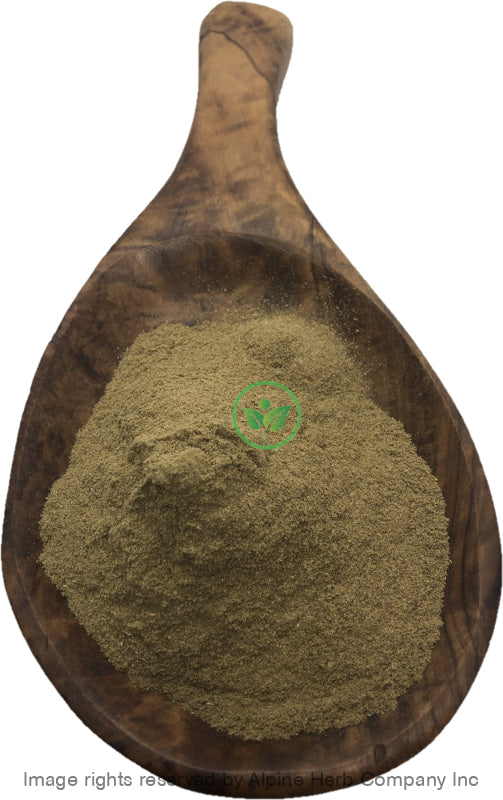Gotukola Leaves Powder Alpine Herb Company Inc.
$ 9,49 $ 5,69
Botanical Name: Centella asiatica
Common Name:
- English: Gotukola, Brahmi
- Also, known as: Manimuni, Marsh Pepperwort, Matoyahuho, Matoyahuhu, Mrang-khua, mtwigahuwu, Pa-na-e-khaa-doh, Phác chèn, Phaknok, Phalwaen, Rau má, Saraswathiaaku, Takip-kohol, Thalkuri, Thankuni, Thol-kuri, Tilkushi, Titjari, Tono’itahi, Tsubo-kusa, Tungchian, Vallari, Vallarei, Vitovitolenge, Water pennywort, Waternavel, Yahon-yahon, Yerba de chavos, Artaniyae-hindi, Asiatic pennywort, Barmanimuni, Barmi, Bhram buti, Boabok, Bodila-ba-dinku, Bokkudu, Brahma manduki, Brahmi ghi, Brahmi-buti, Brahmi, Bua bok, Bua-bok, Centella, Chhota mani-muni, Chi-hsueh-ts’ao, Ghi brahmi, Ghod tapre, Ghodtapre, Ghortapre, Gotu kola, Gotukola, Herba pegagan, Herba kakikuda, Hydrocotyle, Hydrocotyle asiatique, Idrocotile, Imsen korokla, Indian pennywort, Indian water navelwort, Indischer Wassernabel, Karinga, Karivana, Kudangal, luei gong gen, lièn tièn tháo, Mandooka parni, Mandukaparni, Mandukparni, Wassernabel, Idrocotile, Ondelaga, Brahmi soppu, Khodabrahmi, Khadbhrammi, Jholkhuri, Kodangal, Saraswati Aku
Habitat: Throughout India
Origin: India
Harvested: Wild
Parts Used: Leaves
General Information:
There so many important herbs that known as Brahmi. The herb is known as “Brahmi” in the Indian subcontinent and Gotu kola in the western world. Bacopa monnieri is called Brahmi in south India, and Centella asiatica is called Brahmi (or Gotu Kola) in the north of India, where it more commonly grows. Gotukola mostly found on fields and other waste places throughout India up to an altitude of 600 meters. It is also cosmopolitan in its natural distribution and grows along damp shady streams, in ponds, particularly on the marshy land, along the river banks and in irrigated fields. Gotukola is also cultivated in India, Sri Lanka, Malaysia, Indonesia, Madagascar and South Africa, Kenya and Hawaii.
How to use:
Powdered Herb:
There are different ways to use powdered herb.
Food Preparation: You can add powdered herbs to any super food, herbal smoothie, sauces, spreads and even cookies. Also for children, you can mix powdered herbs with honey or glycerin to make a paste. The thicker the paste, the more potent and herbal in taste. The sweet taste of honey and glycerin will help the medicine go down. This method is also known as “Electuaries”.
Capsules: Encapsulating your own powdered herb at home, give you assurance that the contents of the capsules are pure herb and no filler or any other products. These capsules can be taken with liquid.
Poultice: Poultice can be made with an herbal powder and liquid (mostly water) to form a paste which is then applied to the skin. This method is very helpful for skin conditions.
Herbal shot: Powdered herb can be mixed with water, fruit juice or other liquid to make herbal shot.
Precautions:
You should consult with a qualified healthcare practitioner before using any herbal products, particularly if you are pregnant, nursing, or on any medications.
All information on this website is for educational purposes ONLY.
This information has not been evaluated by Health Canada.
This information is not intended to diagnose, treat, cure, or prevent any disease.
| Unit Size | 100g, 200g, 400g, 1kg |
|---|
Prompt shipping and expert packing
Thanks to our longstanding association with UPS FedEx DHL as well as other leading global carriers, we can offer a variety shipping options. Our warehouse staff is highly trained and will be able to pack your goods in accordance with our precise and exact specifications. Your items will go through an exhaustive examination before they will be securely packaged before being delivered. We ship to hundreds of thousands of customers daily in different countries. This is a sign of our determination to become the largest online retailer worldwide. Warehouses and distribution centers are located throughout Europe as well as in the USA.
Note that orders containing multiple items are processed according to the particular item.
We will thoroughly inspect all items ordered before shipping. Most orders are shipped within 48 hours. The delivery time will be between 3 and 7 working days.
Returns
The stock market is always changing. It's not entirely managed by us since we're involved with several entities, including the factory and the storage. Therefore, the actual inventory could fluctuate at any moment. Please be aware that it is possible that your order could be out of stock after you've placed your order.
Our policy lasts for 30 days. If it's been more than 30 days since the date you purchased your item We're sorry to say that we can't offer you a full exchange or refund.
You can only return a product if it is unused and still in the same state as when you received it. The item should be in the original packaging.
Related products
Herb Powder
Herb Powder
Herb Powder
Herb Powder
Herb Powder
Herb Powder
Herb Powder
Herb Powder
Herb Powder
Herb Powder
Herb Powder
Herb Powder
Herb Powder
Herb Powder
Herb Powder
Herb Powder
Herb Powder


































